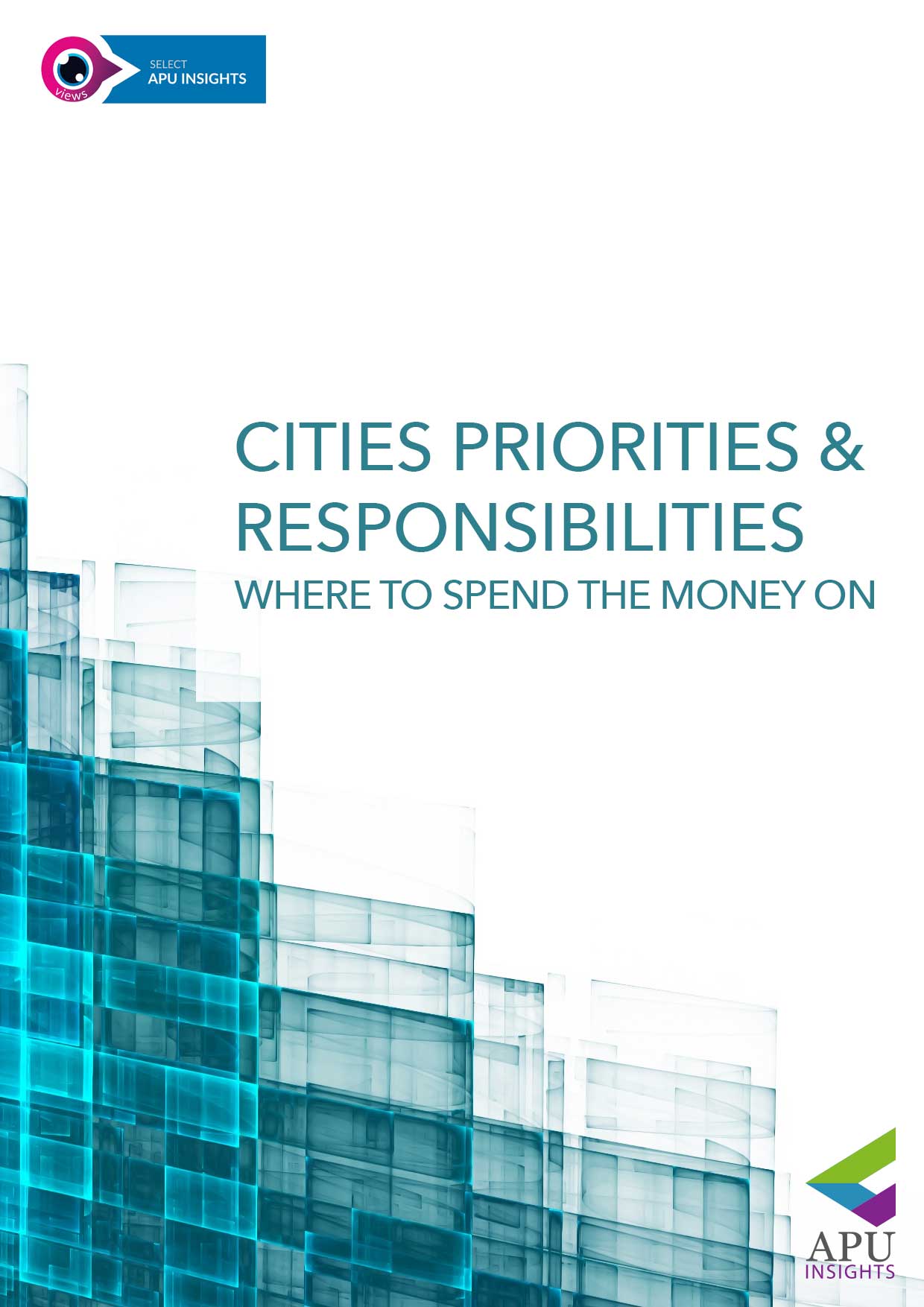Cities Priorities & Responsibilities | Where to spend the money on
Dr. Evangelo Damigos; PhD | Head of Digital Futures Research Desk
- Competitive Differentiation
- Sustainable Growth and Tech Trends
Publication | Update: Sep 2020

To achieve their full economic potential, cities need to be able to provide a multitude of public services — these include investing not only in ‘hard’ infrastructure such as transport networks, clean water, power, and effective waste management but also in other public services such as health, education, cultural facilities, parks, and libraries.
According to the U4 brief, “Towards cities of integrity: The role of urban planners,” by Dieter Zinnbauer, getting urbanization right is a prerequisite for human development and environmental sustainability. Yet, corruption risks in urbanization abound. Corrupted urban planning and development deprives rapidly growing cities of urgently needed resources to expand services and upgrade infrastructures.

While the social and cultural aspects are attractive in their own right, if the employment opportunities are not there, it is unlikely that people will want to live there as, quite simply, they won't be able to afford it. Hence what attracts businesses to a city is of paramount importance. For a business to commit, it needs basic services, (power, water, waste), and crucially, good IT and communications in the form of fiber/broadband. They need accessibility (local, national, and international transport), potentially local sourcing and end markets depending on the product or service, and crucially a supply of appropriate labor.
Of paramount importance is political, legal, and regulatory stability to reduce risk on investment and to enable longer term strategic planning, as well as potentially tax incentives or subsidies on investment. These are also likely to be associated with a 'safer' city where the rule of law is paramount and appropriately enforced, with less crime and corruption.
So a successful city needs to develop both from a business perspective and on a personal/social level to allow this symbiotic relationship to develop fruitfully — to focus too much on one might boost short-term results, but is doomed to ultimate failure.
Differences in spending arise from variations in geography, demographics, history, and other external factors.

Medicaid constitutes a large, and growing, portion of state spending. However, Census does not separate Medicaid spending into its own category. Instead, most Medicaid spending is accounted for under the public welfare category with some spending counted as hospital expenditures.5
The National Association of State Budget Officers (NASBO) estimates that in fiscal year 2019 Medicaid alone accounted for nearly 29 percent of total state spending—up from 20 percent in 2008.6
Highway and road spending was 6 percent, police spending was 4 percent, and corrections spending was 3 percent.
Most of the remaining 25 percent of state and local direct expenditures in 2017 went toward these programs:
- general administration (4 percent)
- interest on debt (4 percent)
- sewerage (2 percent)
- housing and community development (2 percent)
- local fire protection (2 percent)
- parks and recreation (2 percent)
- natural resources services (1 percent)
- air transportation (1 percent)
- solid waste management (1 percent)
- public buildings (1 percent)
When it comes to differences in how cities spend their money, while spend does differ between cities and regions, there are significant areas of commonality, such as education on the operating expenses side and transportation on the capital investment side.

But while much is similar, the most dramatic difference comes in spend per capita between developed and developing markets. While this might seem obvious, it is worth elaborating — not only is the per capita spend in San Francisco a staggering 100 times higher than that of Lagos, developed market cities are much more stable, both in terms of their revenue bases, collection systems, and most importantly the rate of change of needed investment.
Conversely, emerging market cities with those lowest per capita budgets already, are the cities experiencing the most rapid growth in populations, with the most dramatic needs for basic service provision, for populations which are often unlikely to have formal employment and are unlikely therefore to be contributing to urban revenues via taxation or usage charges.
Moreover, as those populations sprawl outwards in unplanned conurbations, the cost of providing those basic services becomes disproportionately large as the areas and distances involved become disproportionately larger.
Cities have different priorities and different responsibilities.
Data show developed markets generally spend far more at a local level on social protection, health, recreation, and the environment,

For example the government of London (GLA and local boroughs) is responsible for London transport which includes underground, overground, buses, taxies, and light rail, but doesn’t include national rail or national airports which are run either privately or by central government.
Some cities have similar priorities
For example New York, London, Lagos, and Delhi spend a large amount of their operational budget on education — 35%, 28% 19%, and 25% in London (GLA and borough’s budget), New York, Lagos, and Delhi, respectively. Where education is not listed in municipal expenses (e.g., San Francisco) it could be delivered by a separate authority or by the state government or grouped up within a sector. Transportation is a significant operational expenditure in London (8% of operational budget of both local boroughs and GLA) and Delhi (9% of operational budget) but it does not account for a very large percentage in other cities budget. San Francisco allocates 32% of its operational budget to public works, transportation, and commerce of which 26% is allocated to the airport commission and 31% to municipal transport. In New York City only 4% is allocated to transport — this is because transportation is delivered by the Metropolitan Transit Authority which is under the responsibility of the State of New York. It is not quite clear from Lagos’ budget documents how much of its recurrent expenditure is used for transportation. In Delhi 58% of its operational budget is allocated to social and community services which include public welfare and urban development.
 Digital Themes: Competitive Differentiation, Sustainable Growth and Tech Trends
Digital Themes: Competitive Differentiation, Sustainable Growth and Tech Trends

HTML
 Access Rights | Content Availability:
Access Rights | Content Availability: 


Objectives and Study Scope
This study has assimilated knowledge and insight from business and subject-matter experts, and from a broad spectrum of market initiatives. Building on this research, the objectives of this market research report is to provide actionable intelligence on opportunities alongside the market size of various segments, as well as fact-based information on key factors influencing the market- growth drivers, industry-specific challenges and other critical issues in terms of detailed analysis and impact.
The report in its entirety provides a comprehensive overview of the current global condition, as well as notable opportunities and challenges.
The analysis reflects market size, latest trends, growth drivers, threats, opportunities, as well as key market segments. The study addresses market dynamics in several geographic segments along with market analysis for the current market environment and future scenario over the forecast period.
The report also segments the market into various categories based on the product, end user, application, type, and region.
The report also studies various growth drivers and restraints impacting the market, plus a comprehensive market and vendor landscape in addition to a SWOT analysis of the key players.
This analysis also examines the competitive landscape within each market. Market factors are assessed by examining barriers to entry and market opportunities. Strategies adopted by key players including recent developments, new product launches, merger and acquisitions, and other insightful updates are provided.
Research Process & Methodology

We leverage extensive primary research, our contact database, knowledge of companies and industry relationships, patent and academic journal searches, and Institutes and University associate links to frame a strong visibility in the markets and technologies we cover.
We draw on available data sources and methods to profile developments. We use computerised data mining methods and analytical techniques, including cluster and regression modelling, to identify patterns from publicly available online information on enterprise web sites.
Historical, qualitative and quantitative information is obtained principally from confidential and proprietary sources, professional network, annual reports, investor relationship presentations, and expert interviews, about key factors, such as recent trends in industry performance and identify factors underlying those trends - drivers, restraints, opportunities, and challenges influencing the growth of the market, for both, the supply and demand sides.
In addition to our own desk research, various secondary sources, such as Hoovers, Dun & Bradstreet, Bloomberg BusinessWeek, Statista, are referred to identify key players in the industry, supply chain and market size, percentage shares, splits, and breakdowns into segments and subsegments with respect to individual growth trends, prospects, and contribution to the total market.
Research Portfolio Sources:
Global Business Reviews, Research Papers, Commentary & Strategy Reports
M&A and Risk Management | Regulation

The future outlook “forecast” is based on a set of statistical methods such as regression analysis, industry specific drivers as well as analyst evaluations, as well as analysis of the trends that influence economic outcomes and business decision making.
The Global Economic Model is covering the political environment, the macroeconomic environment, market opportunities, policy towards free enterprise and competition, policy towards foreign investment, foreign trade and exchange controls, taxes,
financing, the labour market and infrastructure.
We aim update our market forecast to include the latest market developments and trends.
Review of independent forecasts for the main macroeconomic variables by the following organizations provide a holistic overview of the range of alternative opinions:
As a result, the reported forecasts derive from different forecasters and may not represent the view of any one forecaster over the whole of the forecast period. These projections provide an indication of what is, in our view most likely to happen, not what it will definitely happen.
Short- and medium-term forecasts are based on a “demand-side” forecasting framework, under the assumption that supply adjusts to meet demand either directly through changes in output or through the depletion of inventories.
Long-term projections rely on a supply-side framework, in which output is determined by the availability of labour and capital equipment and the growth in productivity.
Long-term growth prospects, are impacted by factors including the workforce capabilities, the openness of the economy to trade, the legal framework, fiscal policy, the degree of government regulation.
Direct contribution to GDP
The method for calculating the direct contribution of an industry to GDP, is to measure its ‘gross value added’ (GVA); that is, to calculate the difference between the industry’s total pretax revenue and its total boughtin costs (costs excluding wages and salaries).
Forecasts of GDP growth: GDP = CN+IN+GS+NEX
GDP growth estimates take into account:

Market Quantification
All relevant markets are quantified utilizing revenue figures for the forecast period. The Compound Annual Growth Rate (CAGR) within each segment is used to measure growth and to extrapolate data when figures are not publicly available.
Revenues
Our market segments reflect major categories and subcategories of the global market, followed by an analysis of statistical data covering national spending and international trade relations and patterns. Market values reflect revenues paid by the final customer / end user to vendors and service providers either directly or through distribution channels, excluding VAT. Local currencies are converted to USD using the yearly average exchange rates of local currencies to the USD for the respective year as provided by the IMF World Economic Outlook Database.
Industry Life Cycle Market Phase
Market phase is determined using factors in the Industry Life Cycle model. The adapted market phase definitions are as follows:

The Global Economic Model
The Global Economic Model brings together macroeconomic and sectoral forecasts for quantifying the key relationships.
The model is a hybrid statistical model that uses macroeconomic variables and inter-industry linkages to forecast sectoral output. The model is used to forecast not just output, but prices, wages, employment and investment. The principal variables driving the industry model are the components of final demand, which directly or indirectly determine the demand facing each industry. However, other macroeconomic assumptions — in particular exchange rates, as well as world commodity prices — also enter into the equation, as well as other industry specific factors that have been or are expected to impact.
Forecasts of GDP growth per capita based on these factors can then be combined with demographic projections to give forecasts for overall GDP growth.
Wherever possible, publicly available data from official sources are used for the latest available year. Qualitative indicators are normalised (on the basis of: Normalised x = (x - Min(x)) / (Max(x) - Min(x)) where Min(x) and Max(x) are, the lowest and highest values for any given indicator respectively) and then aggregated across categories to enable an overall comparison. The normalised value is then transformed into a positive number on a scale of 0 to 100. The weighting assigned to each indicator can be changed to reflect different assumptions about their relative importance.

The principal explanatory variable in each industry’s output equation is the Total Demand variable, encompassing exogenous macroeconomic assumptions, consumer spending and investment, and intermediate demand for goods and services by sectors of the economy for use as inputs in the production of their own goods and services.
Elasticities
Elasticity measures the response of one economic variable to a change in another economic variable, whether the good or service is demanded as an input into a final product or whether it is the final product, and provides insight into the proportional impact of different economic actions and policy decisions.
Demand elasticities measure the change in the quantity demanded of a particular good or service as a result of changes to other economic variables, such as its own price, the price of competing or complementary goods and services, income levels, taxes.
Demand elasticities can be influenced by several factors. Each of these factors, along with the specific characteristics of the product, will interact to determine its overall responsiveness of demand to changes in prices and incomes.
The individual characteristics of a good or service will have an impact, but there are also a number of general factors that will typically affect the sensitivity of demand, such as the availability of substitutes, whereby the elasticity is typically higher the greater the number of available substitutes, as consumers can easily switch between different products.
The degree of necessity. Luxury products and habit forming ones, typically have a higher elasticity.
Proportion of the budget consumed by the item. Products that consume a large portion of the
consumer’s budget tend to have greater elasticity.
Elasticities tend to be greater over the long run because consumers have more time to adjust their behaviour.
Finally, if the product or service is an input into a final product then the price elasticity will depend on the price elasticity of the final product, its cost share in the production costs, and the availability of substitutes for that good or service.
Prices
Prices are also forecast using an input-output framework. Input costs have two components; labour costs are driven by wages, while intermediate costs are computed as an input-output weighted aggregate of input sectors’ prices. Employment is a function of output and real sectoral wages, that are forecast as a function of whole economy growth in wages. Investment is forecast as a function of output and aggregate level business investment.




 Industry: Government and Smart Cities
Industry: Government and Smart Cities 
